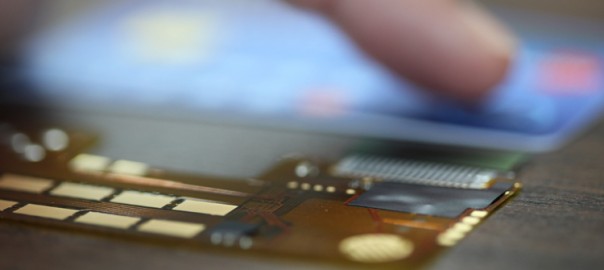
A major change is coming to the way retailers process credit cards — yet less than one-fifth of businesses are prepared.
Over the past few months, banks have begun replacing traditional magnetic strip payment cards with new cards containing a more secure EMV payment chip — named by Europay, MasterCard and Visa, the developers of the technology. Starting on October 1, retailers with a brick-and-mortar, pop-up store or other POS presence must upgrade to the proper card readers to process these safer, chip-enabled cards.
The upcoming deadline is about more than equipping your business with the latest technologies. At that time, a fraud liability shift will take place. In other words, businesses which process chip cards as a magnetic strip card risk taking the hit for any fraudulent transactions instead of payment-processing firms — a price many small businesses cannot afford to pay.
A Long Time in the Making
The shift to chip cards comes in response to ever-rising fraud rates worldwide. Fraud for U.S. merchants is particularly high. In fact, last year the U.S. accounted for nearly half of global losses on credit cards, adding up to $ 8.6 billion, despite transacting only 24% of the world’s credit card sales. And, if EMV technology is not widely adapted, 2015’s credit card fraud is expected to cost upward of $ 10 billion.
EMV, however, is far from new. Although the U.S. is the world’s single largest user of payment cards, it is the last major market to adopt the new technology. Other countries which have already mandated chip cards have seen a favorable improvement in payment security. Within the past four years, fraudster activity declined 79% in Canada and 75% in the U.K.
Over recent years, news of massive data breaches have solidified the need for a major revamp to credit card security practices. In 2013, Target’s holiday season breach of 40 million credit cards illustrated the public relations nightmare that results from improper handling of customer credit card data. In fact, it was not until August 2015 that Target finally reached a $ 67 million settlement with Visa. Negotiations with MasterCard are still on the way.
Despite the undeniable disaster of the breach, Target has become a leader in upgrading to safer EMV technologies not simply among big brands, but within the entire payments industry. Aside from upgrading their card readers for chip-and-pin payments, Target has committed $ 100 billion to change its REDcard portfolio — including branded credit and debit cards — to MasterCard’s chip-and-pin technology.
What Small Businesses Cannot Afford to Ignore
No matter the size of your business, if you offer POS, you will need a new processing device to read chip cards. As opposed to magnetic strip cards that are swiped upon transaction, chip cards remain in the payment terminal for the duration of the entire transaction, allowing the reader and the card to talk in real time. The difference translates to a unique encryption for each sale, as opposed to the static data of a traditional credit card that can be easily counterfeited.
So far, the EMV transition has been slower than expected, with only 1 in 10 U.S. payment card users reporting they have received a chip-enabled card. But with the impending deadline, businesses should plan for distribution of the cards to be complete by October to avoid penalties on fraudulent transactions.
This new financial and legal burden may come as a surprise to small businesses, many of which are unclear about the changes or even completely unaware. According to a recent survey by Intuit of 500 small business owners, 42% did not know about the upcoming deadline to adopt EMV technology. Of those small business who say they will not migrate or remain undecided, 86% may not be able to handle the financial and legal liabilities of the fraudulent transaction.
Despite this, there are many SMBs who know about the upcoming mandate, but have chosen not to make the switch. While 48% of business owners don’t believe the change will affect their business, 36% will not upgrade the card processors because they believe the mandate is unfair.
For many SMBs, fear of the new technology’s cost has kept them from the decision to adopt EMV. Depending on the extent of the business’ POS system, updates can range from around $ 100 to tens of thousands of dollars. To make the transition less painful for many SMBs, Square has offered 250,000 card readers for free to process both chip cards and NFC payments.
Prioritizing Security in an Omnichannel World
As businesses weigh the costs of EMV adoption, issues of customer service must also remain top of mind. Soon, having the correct chip-and-pin payment processor will be an expectation for customers as the distribution process reaches completion and fraud protection insight becomes more widespread.
Indeed, 40% of customers are already highly concerned about the security of their personal information when shopping in store after the newsworthy breaches of retail giants such as Target and Home Depot. Therefore, EMV adoption is not simply an issue of adhering to security standards, but maintaining customer loyalty — a make it or break it quality for small businesses looking to compete with the margin-compromising prices and free shipping offers of online marketplaces and larger retailers.
As holiday planning reaches its peak and retailers prepare to optimize their omnichannel offerings, remember that the EMV mandate is an opportunity to build a sense of trust with your customers and prove you have their security concerns properly addressed. Whether you are expecting more foot traffic to your brick-and-mortar or even launching special pop-up stores for the season, upgrading for chip cards is a growth strategy for the long-term.
Photo: Robert Scoble
Business & Finance Articles on Business 2 Community(217)






